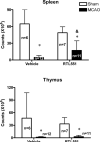Recombinant T cell receptor ligand treats experimental stroke
- PMID: 19443805
- PMCID: PMC2704258
- DOI: 10.1161/STROKEAHA.108.543991
Recombinant T cell receptor ligand treats experimental stroke
Abstract
Background and purpose: Experimental stroke induces a biphasic effect on the immune response that involves early activation of peripheral leukocytes followed by severe immunodepression and atrophy of the spleen and thymus. In tandem, the developing infarct is exacerbated by influx of numerous inflammatory cell types, including T and B lymphocytes. These features of stroke prompted our use of recombinant T cell receptor ligands (RTL), partial major histocompatibility complex Class II molecules covalently bound to myelin peptides. We tested the hypothesis that RTL would improve ischemic outcome in the brain without exacerbating defects in the peripheral immune system function.
Methods: Four daily doses of RTL were administered subcutaneously to C57BL/6 mice after middle cerebral artery occlusion, and lesion size and cellular composition were assessed in the brain and cell numbers were assessed in the spleen and thymus.
Results: Treatment with RTL551 (I-A(b) molecule linked to MOG-35-55 peptide) reduced cortical and total stroke lesion size by approximately 50%, inhibited the accumulation of inflammatory cells, particularly macrophages/activated microglial cells and dendritic cells, and mitigated splenic atrophy. Treatment with RTL1000 (HLA-DR2 moiety linked to human MOG-35-55 peptide) similarly reduced the stroke lesion size in HLA-DR2 transgenic mice. In contrast, control RTL with a nonneuroantigen peptide or a mismatched major histocompatibility complex Class II moiety had no effect on stroke lesion size.
Conclusions: These data are the first to demonstrate successful treatment of experimental stroke using a neuroantigen-specific immunomodulatory agent administered after ischemia, suggesting therapeutic potential in human stroke.
Figures



Similar articles
-
Novel humanized recombinant T cell receptor ligands protect the female brain after experimental stroke.Transl Stroke Res. 2014 Oct;5(5):577-85. doi: 10.1007/s12975-014-0345-y. Epub 2014 May 18. Transl Stroke Res. 2014. PMID: 24838614 Free PMC article.
-
Therapy with recombinant T-cell receptor ligand reduces infarct size and infiltrating inflammatory cells in brain after middle cerebral artery occlusion in mice.Metab Brain Dis. 2011 Jun;26(2):123-33. doi: 10.1007/s11011-011-9241-2. Epub 2011 Apr 7. Metab Brain Dis. 2011. PMID: 21472429 Free PMC article.
-
A novel HLA-DRα1-MOG-35-55 construct treats experimental stroke.Metab Brain Dis. 2014 Mar;29(1):37-45. doi: 10.1007/s11011-013-9440-0. Metab Brain Dis. 2014. PMID: 24122483 Free PMC article.
-
Recombinant T-cell receptor ligand RTL1000 limits inflammation and decreases infarct size after experimental ischemic stroke in middle-aged mice.Neuroscience. 2015 Mar 12;288:112-9. doi: 10.1016/j.neuroscience.2014.12.037. Epub 2014 Dec 31. Neuroscience. 2015. PMID: 25556831 Free PMC article.
-
Recombinant T cell receptor ligands: immunomodulatory, neuroprotective and neuroregenerative effects suggest application as therapy for multiple sclerosis.Rev Neurosci. 2008;19(4-5):327-39. doi: 10.1515/revneuro.2008.19.4-5.327. Rev Neurosci. 2008. PMID: 19145988 Free PMC article. Review.
Cited by
-
A novel mouse model of thromboembolic stroke.J Neurosci Methods. 2015 Dec 30;256:203-11. doi: 10.1016/j.jneumeth.2015.09.013. Epub 2015 Sep 18. J Neurosci Methods. 2015. PMID: 26386284 Free PMC article. Review.
-
Novel humanized recombinant T cell receptor ligands protect the female brain after experimental stroke.Transl Stroke Res. 2014 Oct;5(5):577-85. doi: 10.1007/s12975-014-0345-y. Epub 2014 May 18. Transl Stroke Res. 2014. PMID: 24838614 Free PMC article.
-
DRα1-MOG-35-55 Reduces Permanent Ischemic Brain Injury.Transl Stroke Res. 2017 Jun;8(3):284-293. doi: 10.1007/s12975-016-0514-2. Epub 2016 Dec 17. Transl Stroke Res. 2017. PMID: 27988839 Free PMC article.
-
Targeting microglial activation in stroke therapy: pharmacological tools and gender effects.Curr Med Chem. 2014;21(19):2146-55. doi: 10.2174/0929867321666131228203906. Curr Med Chem. 2014. PMID: 24372213 Free PMC article. Review.
-
TCR-like antibodies distinguish conformational and functional differences in two- versus four-domain auto reactive MHC class II-peptide complexes.Eur J Immunol. 2011 May;41(5):1465-79. doi: 10.1002/eji.201041241. Epub 2011 Apr 12. Eur J Immunol. 2011. PMID: 21469129 Free PMC article.
References
-
- Nilupul PM, Ma HK, Arakawa SM, Howells DW, Markus R, Rowe CC, Donnan GA. Inflammation following stroke. J CLIN NEUROSCI. 2006;13:1–8. - PubMed
-
- Gee JM, Kalil A, Connor Shea C, Becker K. Lymphocytes- Potential Mediators of Postischemic Injury and Neuroprotection. STROKE. 2007;38:783–88. - PubMed
-
- Wang P-Y, Kao C-H, Mui M-Y, Wang S-J. Leukocyte Infiltration in Acute Hemispheric Ischemic Stroke. STROKE. 1993;24:236–240. - PubMed
-
- Stevens SL, Bao J, Lessov NS, Clark WM, Stenzel-Poore MP. The use of flow cytometry to evaluate temporal changes in inflammatory cells following focal cerebral ischemia in mice. BRAIN RESEARCH. 2002;932:110–19. - PubMed
-
- Yilmaz G, Arumugam TV, Stokes KY, Granger DN. Role of T lymphocytes and interferon-gamma in ischemic stroke. CIRCULATION. 2006;113:2105–112. - PubMed
Publication types
MeSH terms
Substances
Grants and funding
LinkOut - more resources
Full Text Sources
Other Literature Sources
Medical
Research Materials

